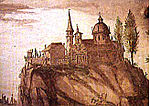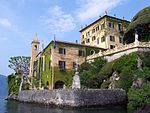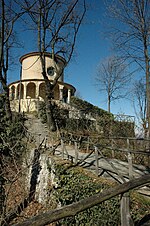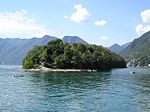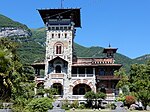Benito Mussolini, the deposed Italian fascist dictator, was summarily executed by an Italian partisan in the village of Giulino di Mezzegra in northern Italy on 28 April 1945, in the final days of World War II in Europe. The generally accepted version of events is that Mussolini was shot by Walter Audisio, a communist partisan. However, since the end of the war, the circumstances of Mussolini's death, and the identity of his executioner, have been subjects of continuing dispute and controversy in Italy.
In 1940, Mussolini took his country into World War II on the side of Nazi Germany but soon was met with military failure. By the autumn of 1943, he was reduced to being the leader of a German puppet state in northern Italy and was faced with the Allied advance from the south and an increasingly violent internal conflict with the partisans. In April 1945, with the Allies breaking through the last German defences in northern Italy and a general uprising of the partisans taking hold in the cities, Mussolini's situation became untenable. On 25 April he fled Milan, where he had been based, and headed towards the Swiss border. He and his mistress, Claretta Petacci, were captured on 27 April by local partisans near the village of Dongo on Lake Como. Mussolini and Petacci were executed the following afternoon, two days before Adolf Hitler's suicide.
The bodies of Mussolini and Petacci were taken to Milan and left in a suburban square, the Piazzale Loreto, for a large angry crowd to insult and physically abuse. They were then hung upside down from a metal girder above a service station on the square. Initially, Mussolini was buried in an unmarked grave but, in 1946, his body was dug up and stolen by fascist supporters. Four months later it was recovered by the authorities who then kept it hidden for the next eleven years. Eventually, in 1957, his remains were allowed to be interred in the Mussolini family crypt in his home town of Predappio. His tomb has become a place of pilgrimage for neo-fascists and the anniversary of his death is marked by neo-fascist rallies.
In the post-war years, the "official" version of Mussolini's death has been questioned in Italy (although not internationally, in general) in a manner that has drawn comparison with the John F. Kennedy assassination conspiracy theories. Some journalists, politicians and historians, doubting the veracity of Audisio's account, have advanced a wide variety of theories and speculation as to how Mussolini died and who was responsible. At least twelve different individuals have, at various times, been claimed to be the killer. These have included Luigi Longo and Sandro Pertini who subsequently became general secretary of the Italian Communist Party and President of Italy respectively. Some writers believe that Mussolini's death was part of a Special Operations Executive operation, with the supposed aim of retrieving compromising "secret agreements" and correspondence with Winston Churchill that Mussolini had allegedly been carrying when he was captured. However, the "official" explanation, with Audisio as Mussolini's executioner, remains the most credible narrative.


